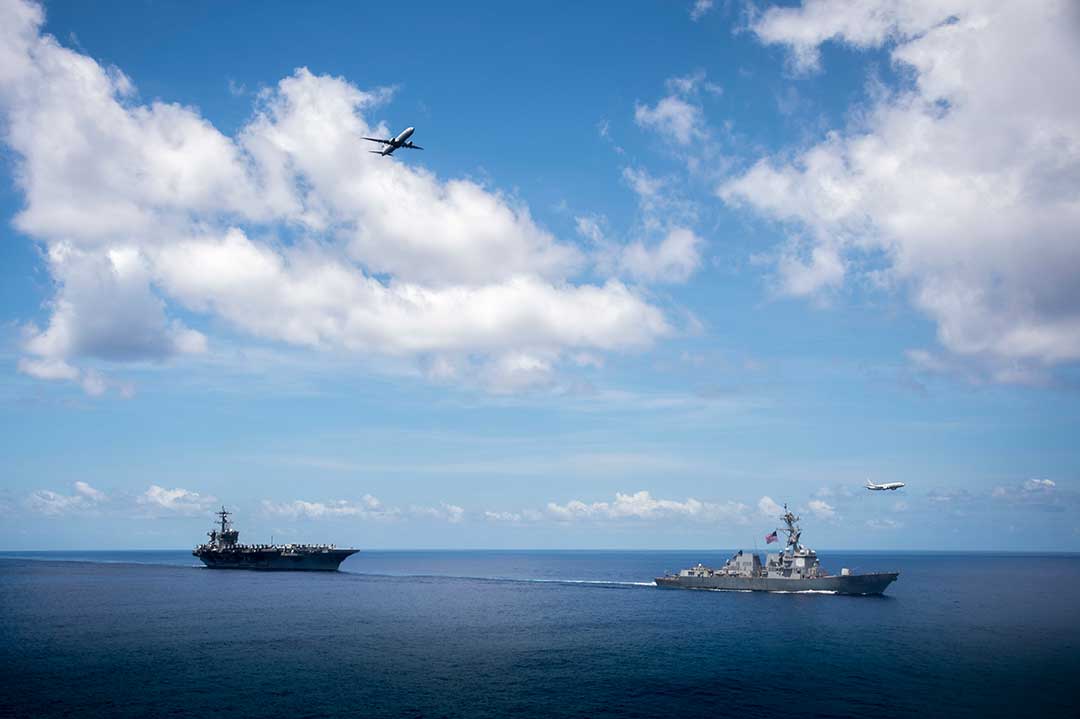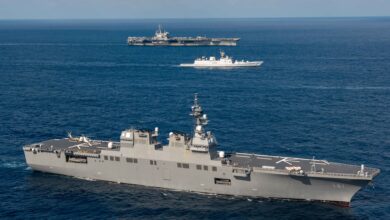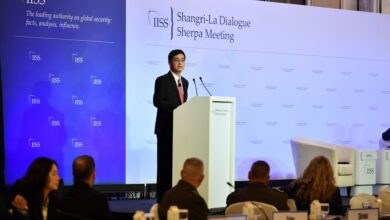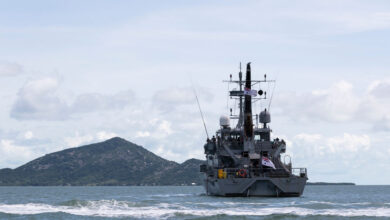U.S. Navy carrier strike group, Royal Australian Navy conduct bilateral exercise

Ensign Charena Camacho/U.S. Navy
The United States Navy’s Carl Vinson Carrier Strike Group conducted a bilateral training exercise with the Royal Australian Navy (RAN) and Royal Australian Air Force in December 2021 to test and refine warfighting principles.
The RAN and the U.S. Navy joined to deploy high-end training tactics and improve proficiencies in advanced kinetic and nonkinetic capabilities designed to project dominance in a multidomain threat environment. (Pictured: The U.S. Navy’s Arleigh Burke-class guided-missile destroyer USS Stockdale and Nimitz-class aircraft carrier USS Carl Vinson transit the Indian Ocean accompanied by two Royal Australian Air Force P-8A Poseidon aircraft during a bilateral exercise in December 2021.)
“Conducting advanced kinetic and nonkinetic bilateral exercises with our allies and partners increases our collective ability to outthink and outfight any adversary threatening our open seas,” said U.S. Navy Rear Adm. Dan Martin, commander of Carrier Strike Group One (CSG 1). “Our long-term alliances and partnerships in the Indo-Pacific region preserve maritime prosperity and international order and enable seamless integration, communication and collaboration across the region.”
The multiphase exercise was conducted over several weeks and included events such as enhanced maritime communication tactics, electronic warfare operations and integrated anti-air, anti-surface operations.
Naval units conducted and evaluated joint integrated surface and air engagements to further increase collective warfighting readiness, maritime superiority and power projection in the Indo-Pacific.
“The Australia-U.S. alliance increases our ability to protect ourselves and our interests, and we work as like-minded countries to address security challenges in the Indo-Pacific,” said Rear Adm. Mark Hammond, commander of the Australia Fleet. “Opportunities to practice and prove our tactics and rapidly build shared understanding in order to respond together further our interoperability. We have sustained a comprehensive program of navy-to-navy engagement with the United States Navy throughout 2021, and I look forward to continuing to work as partners in years to come.”
The HMAS Warramunga represented the RAN in the exercise.
U.S. Navy units included: aircraft carrier USS Carl Vinson; Ticonderoga-class guided-missile cruiser USS Lake Champlain; Arleigh Burke-class guided-missile destroyer USS Stockdale of Destroyer Squadron 1; Henry J. Kaiser-class fleet replenishment ships USNS Rappahannock and USNS John Ericsson; and nine squadrons of embarked Carrier Air Wing (CVW) 2.
CVW-2 consists of: an F-35C squadron, the “Argonauts” of Strike Fighter Squadron (VFA) 147; three F/A-18E/F Super Hornet squadrons, the “Bounty Hunters” of VFA-2, the “Stingers” of VFA-113 and the “Golden Dragons” of VFA-192; the “Gauntlets” of Electronic Attack Squadron 136, operating the EA-18G Growler; the “Black Eagles” of Airborne Command and Control Squadron 113, operating the E-2D Advanced Hawkeye; the “Titans” of Fleet Logistics Multi-Mission Squadron 30, operating the CMV-22B Osprey; the “Black Knights” of Helicopter Sea Combat Squadron 4, operating the MH-60S Sea Hawk; and the “Blue Hawks” of Helicopter Maritime Strike Squadron 78, operating the MH-60R Sea Hawk.
CSG 1 is deployed to the U.S. 7th Fleet area of operations in support of a Free and Open Indo-Pacific region.
IMAGE CREDIT: PETTY OFFICER 2ND CLASS HAYDN N. SMITH/U.S. NAVY




